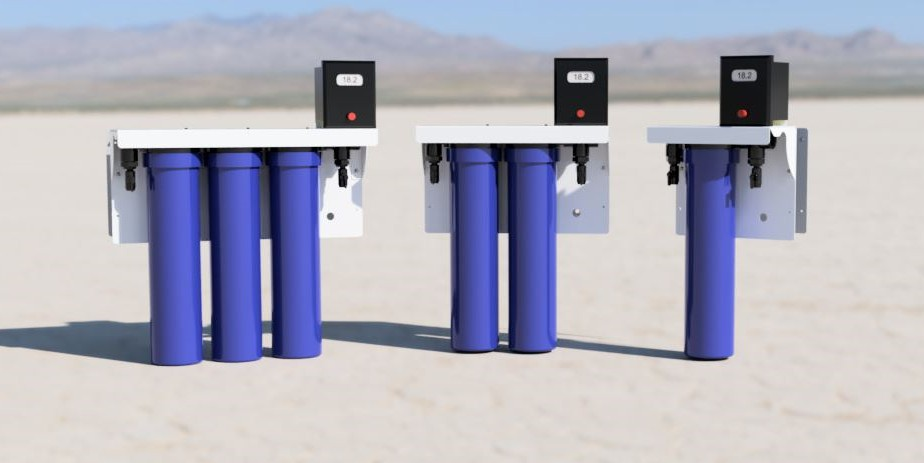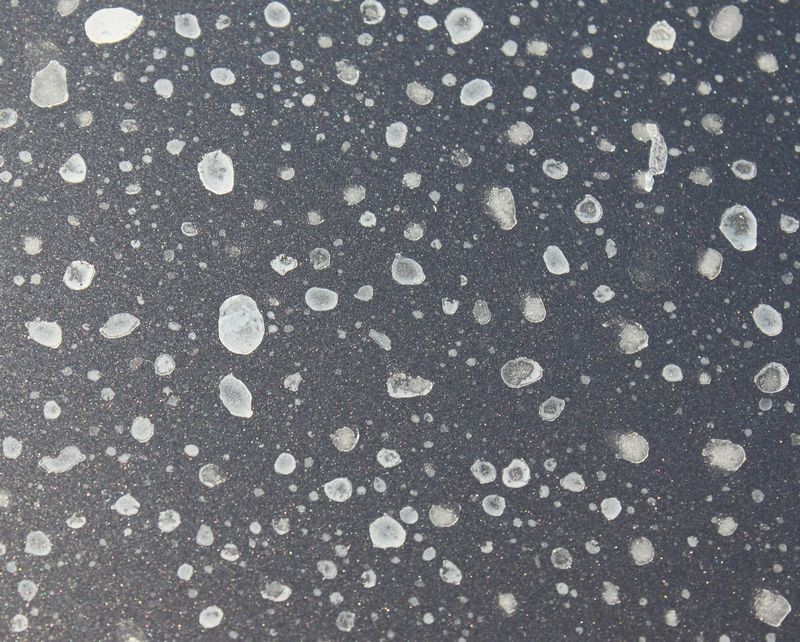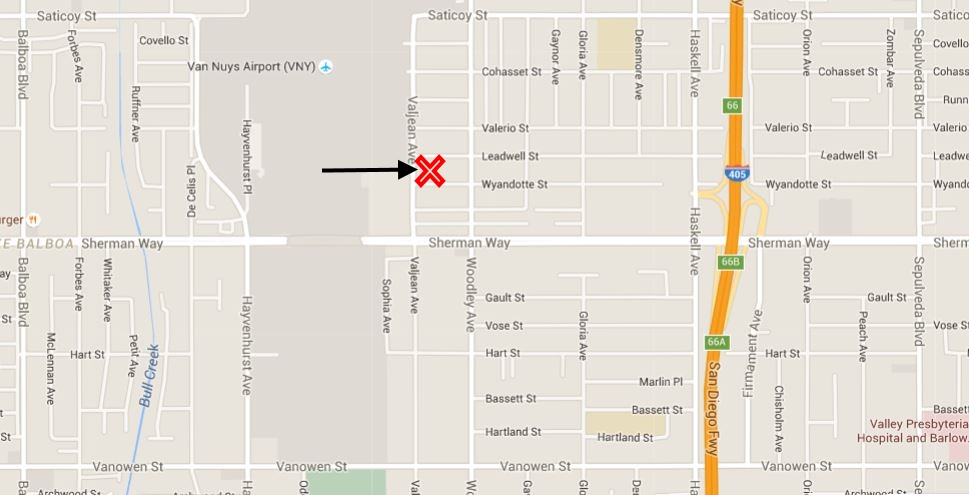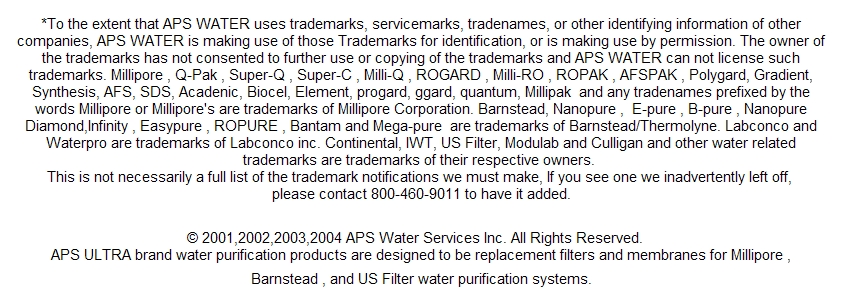|
Spot Free Water Products
Great Filtration Products and Support |
An APSWATER Micro-Website™
A US Government Supplier DUNS 787700418 Rated "A+" with the BBB 33 years, Zero Complaints Click here to see our record |
 |
ON SALE NOW Introducing the Polaris Lab Water Systems High Purity Water Made In The USA. Click here for more info. |
How To Make Spot Free Water
Water Softeners Do Not Produce Spot Free Water
Water spots are causes by minerals in water. In order to have spot free water you have to remove all the minerals. Water softeners only trade one mineral for another. Water spots are minerals that were dissolved in the water and are left behind when the water evaporates.
What Causes Water Spots?
 |
Water spots form when water that contained minerals evaporated leaving behind the minerals that were once dissolved in the water. All untreated water contains minerals. It can be Calcium, Sodium, Magnesium, Aluminum or just about anything seen on the periodic table. There is an easy demonstration that most of us have done without even realizing it. Most of us at some point have set water to boil on the stove and then forgot about it. When we finally remember we are left with a pot that has the bottom coated in hard white deposits. You may have seen the same thing with water left outside to evaporate. As the water turns to vapor and floats away, the heavier minerals stay behind and concentrate on the surface. This is know as scale. |
There are two types of scale that form on surfaces. They are known as Soluble and Insoluble scale.
Soluble scale forms form softer minerals in the water such as sodium or silica. You can usually easily wipe them off of the surface with a dry cloth and they can appear similar to dust in the shape of a water droplet. Soluble scale will easily re-dissolve back into water.
insoluble scale forms form hard minerals in water such as calcium, magnesium and carbonates. The most common hard water scale is calcium carbonate, which is very close to concrete. Insoluble scale will not easily wipe off and will require changing the pH in order to re-dissolve it back into water.
For those wanting spot free surfaces, you will need to deal with both the soluble and insoluble minerals in the water.
Why Water Softeners Do Not Make Spot Free Water
 |
There are many devices on the market that claim to produce spot free water that do not.
The water coming out of a softener will contain roughly the same amount of spotting minerals that you started with. Soft Water can contain a lot of chloride which can cause pitting and degregation of metal surfaces. You should never need to wipe down a surface that uses spot free water. It is also important to know that water on horizontal surfaces will usually fall off before evaporating and leaving a water spot. |
See More : Water Softeners Do Not Produce Spot Free Water
Spot Free Surfaces Require Mineral Free Water
There are only three basic ways that you can produce Spot Free Rinse Water.
We find that Reverse Osmosis is best for producing spot free water. RO is the cheapest to produce per gallon and leaves the best looking sufrace and paint. Reverse Osmosis water is pure enopugh not to leave spots, but it not too pure that it dissolves waxes and un-protected metal surfaces.
- Superior Finish
- Low Cost Per Gallon
- User Serviceable
2. Deionization
Deionization removes 100% of the + and - charged minerals. It will provide a very clean spot free surface. Deionized water will etch the surface of any unprotected metal. For this reason it is best used for parts and window washing. For automobiles and painted surfaces it can be used, but Reverse Osmosis Water is far better.
- Superior for windows and pre-paint or powder coating
- Medium cost per gallon
- User serviceable with filters but can not be home regenerated
3. Distillation
Distillation works by boiling water and then cooling and capturing the steam. The re-condensed water is the most pure compared to the other but only untill it combines with air. Since the products rates can be low, distilled water us always stored until there is enough water to use. When it is stored is absorbs Carbon Dioxide from the air and forms carbonic acid. They pH of stored distilled or deionized water can be as low as 5.5 making it an acid.
- Removes the most contaminants
- Produces Bacteria Free Water
- Energy cost can be higher then a non-pump driven RO system.
- Is User Serviceable
These processes all remove both the positive and negative ions in water and will give you spot free rinse water.

Don't want Paypal?
Click here to use our main site
APSWATER.com
for all other options
Purchase Orders Accepted
(subject to approval)
Credit Application
Jump To Our Main Site
|
Menu
Home About Us Spot Free Products Spot Free Filter Myth Softeners Don't Work Periodic Table |

Contact Us
818-786-0600
800-460-9011 Toll Free
818-786-2347 Fax
E-Mail Us

Get Travel Directions

All Images are representative and may or may not be of actual product.
SPOT-FREE-WATER.COM content (C)2009-2024 APS Water Services Corporation - All rights reserved
Website Software - Multi-Website Content Manager - Wilson Web Engineering (C)2012-2024
Micro-Website is a trademark of Wilson Web Engineering
how make spot free water
11/21/2024
4:57:57 AM

| Other APS Web Properties | Barnstead-Water.com | lab-Water-filters.com | lab-water System.com | LabFilter.com | Millipore-alternative.com | Durastill Water DIstillers.com |